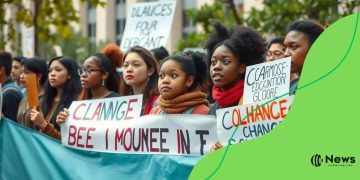Legal protection for student-led media: what you need to know
Legal protection for student-led media is essential, as it ensures students can express themselves freely while providing guidance against censorship and fostering a supportive environment for young journalists.
Legal protection for student-led media is essential for empowering young journalists to express themselves freely. Have you ever wondered what safeguards exist for student voices in educational institutions? Let’s dive into this important topic.
Understanding student-led media rights
Understanding student-led media rights is essential for fostering free expression in schools. Students often face unique challenges when it comes to sharing their views through media. By knowing their rights, they can navigate these challenges effectively.
Key Aspects of Student Media Rights
First, it’s important to recognize that students have a right to engage in media that reflects their thoughts and opinions. This right is protected under the First Amendment. However, there are some specific limitations, especially in a school environment. Understanding these can help students stay within legal boundaries while expressing themselves.
- Freedom of speech: Students can express their ideas freely, but must avoid harmful or disruptive speech.
- Editorial control: Student media must have the ability to make decisions about content without undue influence from school officials.
- Access to resources: Schools should support student media by providing necessary resources, like funding and training.
- Protection from censorship: Administrators cannot censor student publications unless there are strong reasons, like safety concerns or violating school policies.
Additionally, schools should create policies that support student media projects. By implementing clear guidelines, schools can help students feel secure as they navigate media creation and expression. For instance, having open channels of communication can prevent misunderstandings between students and faculty.
Common Challenges Students Face
Despite these rights, many students encounter challenges when producing media. Some students may experience censorship or fear of backlash from peers or faculty. Understanding these risks is crucial for student journalists.
The ability to report on school events and issues can empower students and raise awareness within the community. It enhances the educational experience by promoting critical thinking and responsible communication.
Key legal protections for students
Key legal protections for students play a critical role in ensuring that their voices are heard within educational settings. Understanding these protections helps students navigate their rights effectively.
Overview of Legal Protections
Students are granted several protections under U.S. law. The First Amendment is fundamental, providing the right to free speech. This means students can express themselves through various mediums, including newspapers, videos, and social media, as long as it does not disrupt the learning environment.
- Title IX: Protects students from discrimination based on sex, ensuring a safe educational environment.
- The Family Educational Rights and Privacy Act (FERPA): Keeps student educational records private and secure.
- The Equal Access Act: Requires schools to provide equal access to extracurricular activities, including student media groups.
- Free Speech Rights: Shields students from unjust censorship of their media and publications.
Moreover, legal protections also extend to issues like harassment and discrimination. Schools must provide a safe learning environment free from bullying and other forms of harassment. Students can report incidences and receive support from their school administrations.
Understanding the Reporting Process
When students face violations of these protections, knowing how to report issues is crucial. Schools often have procedures in place that outline steps for filing complaints.
Students can start by talking to a trusted teacher or counselor. If necessary, they can escalate their concerns to the school administration. Having clear policies in place ensures that student grievances are taken seriously and addressed quickly. It’s vital for students to familiarize themselves with these procedures to advocate for their rights effectively.
Ultimately, these legal protections are designed to empower students and uphold their rights within the educational system. Having knowledge about these laws helps students feel confident in their ability to express themselves and speak up against injustice.
Challenges in student journalism

Challenges in student journalism can hinder the ability of young writers to express themselves. One major challenge is facing censorship from school officials. Many students worry that their stories will be edited or removed before publication, which can stifle their voices.
Common Obstacles Faced by Student Journalists
- Lack of funding: Limited resources can prevent students from accessing necessary supplies like cameras and printing services.
- Censorship: Some school administrators may try to control the content of articles, leading to fear of backlash.
- Time constraints: Balancing schoolwork with journalism can be tough, leading to stress and burnout.
- Inexperience: Many students do not receive formal training in journalism, making it challenging to create quality content.
Furthermore, students may also encounter issues when addressing sensitive topics. These can include issues related to race, gender, or local controversies. Speaking out on such topics requires courage and can sometimes lead to backlash from peers or authority figures.
Building Confidence in Reporting
Building confidence is essential for overcoming these challenges. Students must learn to trust their instincts and report responsibly. Developing strong relationships with mentors, such as teachers or local journalists, can provide valuable guidance and support.
Moreover, creating safe spaces for discussion and idea-sharing can foster a sense of community among student journalists. Collaborating with peers can help them feel empowered and less isolated in their pursuit of reporting. It’s important for student journalists to advocate for their rights and understand the impact their voices can have.
Best practices for protecting student media
Best practices for protecting student media are essential for ensuring that student voices are heard and respected. By following these practices, schools can support student journalists in their efforts to report fairly and honestly.
Establish Clear Policies
Having clear and comprehensive policies is a foundational step in protecting student media. Schools should outline the rights and responsibilities of both students and faculty. This includes guidelines on what constitutes acceptable content and how disputes will be resolved. Transparent policies help to set expectations and foster an environment of trust and respect.
- Define editorial control: Students should have the right to make decisions about their publications.
- Ensure support: Faculty advisors should be available to guide and support student journalists without imposing undue influence.
- Encourage feedback: Allow students to express their concerns or suggestions about the media policies.
- Regular training: Conduct workshops to educate students about their rights and journalistic ethics.
Additionally, schools need to provide the necessary resources for student media. This includes funding for materials, access to technology, and opportunities for professional development. Resources enhance the quality of student reporting and empower students to pursue their journalistic passions.
Encourage Open Communication
Encouraging open communication between students and faculty is key to a successful student media program. When students feel comfortable discussing their ideas and concerns, they are more likely to engage in responsible reporting.
Creating forums for dialogue can facilitate healthy discussions about the media production process. Schools should host regular meetings where students can share their experiences and ask questions. These interactions help build a supportive community around student journalism.
Lastly, emphasizing the importance of ethical reporting is crucial. Students should understand their role as journalists and the potential impact of their work. By instilling a strong sense of ethics, schools can help students navigate the responsibilities that come with sharing news and opinions.
How schools can support student media initiatives
How schools can support student media initiatives is an important topic for fostering a vibrant environment for young journalists. By providing the right resources and encouragement, schools can empower students to explore journalism and express their voices effectively.
Providing Resources and Funding
One of the key ways to support student media is through adequate resources. Schools should allocate funding specifically for student media projects. This funding can cover essential items like equipment, printing costs, and software for digital content creation.
- Invest in technology: Providing access to computers, cameras, and editing software is crucial for student projects.
- Secure funding for activities: Organizing workshops, competitions, and guest lectures can enhance learning.
- Maintain a space for student media: Designate a dedicated area where students can meet, collaborate, and create their media content.
- Encourage participation: Highlight student media in school events to promote involvement from all students.
Moreover, training opportunities can help students develop their skills. Workshops led by experienced journalists can cover topics such as writing, editing, and ethics in journalism. This training not only boosts confidence but also improves the quality of the content produced.
Creating an Inclusive Environment
It’s essential for schools to foster an inclusive environment where all voices are welcome. This can be achieved by inviting diverse perspectives and encouraging students from different backgrounds to participate in media initiatives. Schools should promote equal representation in student media teams, opening the door for varied narratives and stories.
Having a mentorship program can also help students navigate their journalism journey. Experienced teachers or local media professionals can act as mentors, guiding students through the challenges of reporting and publication.
Encouraging open dialogues about the importance of student media can change the culture of the school. When students see their peers expressing themselves and valuing their work, it inspires others to join in. Schools can also use newsletters, social media, and assemblies to showcase student journalism, helping build a strong community around student media.
In conclusion, supporting student media initiatives is crucial for empowering young journalists. Schools can create a strong foundation by providing resources, fostering open communication, and promoting inclusivity. When students feel supported in their efforts to express themselves, they become more confident and engaged in their work. These practices not only enhance the quality of student journalism but also contribute to a vibrant school community that values diverse voices.
FAQ – Frequently Asked Questions about Student Media Initiatives
How can schools support student media projects?
Schools can provide resources, conduct training, and create an environment that encourages participation in media activities.
What are the benefits of student media for schools?
Student media enhances communication skills, fosters critical thinking, and encourages civic engagement among young individuals.
What challenges do student journalists face?
Common challenges include censorship, lack of funding, time constraints, and insufficient experience in journalism.
How can students overcome these challenges?
Students can seek mentorship, collaborate with peers, and advocate for their rights to create more inclusive media environments.





